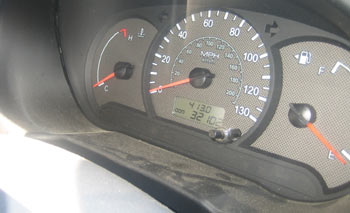

 |

|
http://money.cnn.com/2007/05/14/news/economy/gas_boycott/index.htm One of the suggested methods was driving slower. This price-fighting tactic has absolutely no sex appeal, but requires only the tiniest sacrifice from participants. I was interested, and decided to conduct a really boring test, with two tanks of gas. |
Introduction
|

First Tank Slow The technique seemed to work. I had more than 200 miles on my trip odometer before I got to the half-way mark on my tank, which is more than usual. This was totally going to work! Could I really get 400 miles on a single tank? After ten days, the first tank of gas was almost gone. my "low fuel" warning light came on at 398 miles, and at 413 miles, I stopped for gasoline. This was pretty damn good. I couldn't remember ever getting such good mileage in this car. I filled the tank with 10.1 gallons, which indicates that slow driving had yielded 40.9 miles per gallon.
|
Now, instead of other cars passing me, I was doing most of the passing. I also accelerated more aggressively. Driving fast is fun. Accelerating is fun. I also stopped using my turn signal and started using my horn, basically the complete jackass package. Of course, I didn't spend the whole tank zipping along at 77. That was just my new top speed.
Half a tank got me further than I expected, 200 miles, but after 339 miles, the gas light came on.
|
Translated into dollars, and using a consistent price of fuel ($3/gallon): Personal Impact is probably Negative 7 cents vs. 9 cents a mile? Each mile I drove slow, I was saving 1.8 cents, but it was costing me 8.4 seconds! At this rate, I would need to spend an extra hour in the car to save $7.71. For a lot of people this amount of savings won' t be enough to justify driving slowly. |
|
One of the points made in that "gas-out" newspaper article had been that even a small decrease in the amount of gasoline used would cut the price significantly. The price of oil and gasoline fluctuate according to how much supply is available. If the on-hand reserves of oil and gasoline are small, the price tends to rise. America doesn't need to cut its gasoline use by 50% to cut the price by 50%. We only need to cut the use by 5% to see reserves accumulate, which will definitely drag the price down. I really believe that cutting back 5% is possible. I am not going to ask you to take a bus to work, because I, myself won't do that. But I am asking you to try doing something, and the thing that is least painful has got to be driving slow. You have a choice about the way you burn fuel in your car. Try the "driving slow" challenge by limiting your top speed to 65 mph. The next time you fill up, hit your trip odometer and stretch your fuel use to the maximum. Let me know how it goes!
|
|
|
Spaghetti | How much is inside other stuff? | Mustard | Glad wrap | Batteries | Goldschlager | Paper Towels | A Sharpie | Bacon Bits | Dial Complete | A Pumpkin | An Acre | A Keg | Popcorn | Home | Contact Rob | Staff Page February 5th, 2008. |